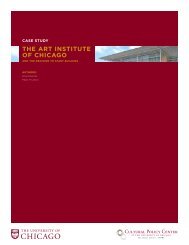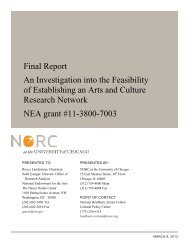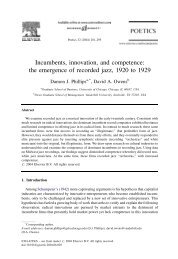across <strong>in</strong>stitutions, whether for structural or adm<strong>in</strong>istrative reasons. For example, <strong>in</strong><strong>in</strong>stitutions present<strong>in</strong>g the perform<strong>in</strong>g arts, buy<strong>in</strong>g a ticket is the most basic level ofparticipation; <strong>in</strong> museums, it is a museum visit. In both types of <strong>in</strong>stitutions, higher levelsof participation may be <strong>in</strong>dicated by season-ticket hold<strong>in</strong>g, or some form of membership.The basic unit <strong>in</strong> the analysis is geographical, not <strong>in</strong>dividual.Us<strong>in</strong>g databases of census tracts and street addresses, the National Op<strong>in</strong>ion Research<strong>Center</strong> (NORC) at the University of <strong>Chicago</strong> geocoded all addresses <strong>in</strong> our data set; thelocation of each address <strong>in</strong> our files was identified, and the address was mapped onto theappropriate street segment. This analysis makes it possible to produce maps show<strong>in</strong>g thedistribution of activity across the entire <strong>Chicago</strong> MSA and beyond.Furthermore, it makes l<strong>in</strong>kage possible between our records of participation <strong>in</strong> cultural<strong>in</strong>stitutions and data about the community available elsewhere. Our primary source ofexternal data is the 2000 Census, which provides <strong>in</strong>formation, also based on censustracts, on socioeconomic characteristics such as <strong>in</strong>come, education, and householdcomposition, as well as crucial data on race and ethnicity.Though we can l<strong>in</strong>k household addresses <strong>in</strong> the database to specific areas, we need totake <strong>in</strong>to account the size of the population <strong>in</strong> each location to be able to compare andcontrast areas. We choose density of participation as our first measure, where density ismeasured as the proportion of households <strong>in</strong> an area that participate <strong>in</strong> at least one ofthese <strong>in</strong>stitutions. In calculat<strong>in</strong>g levels of participation we use population basel<strong>in</strong>e datafrom the 2000 Census; changes <strong>in</strong> population size and composition s<strong>in</strong>ce 2000 are notreflected <strong>in</strong> our measures. 4From census figures, we know the characteristics of the areas where people live,but we do not know the characteristics of the <strong>in</strong>dividuals or hous<strong>in</strong>g units <strong>in</strong> ourown database.Individual names and identification are removed from the records before we analyzethem, and we have no access to personal characteristics of <strong>in</strong>dividuals or families.A household can appear multiple times <strong>in</strong> the overall database, either because it hasmultiple transactions with a particular organization, or because it has transactions withmany organizations, or both. We measure participation as a household’s <strong>in</strong>volvement withat least one organization. In select<strong>in</strong>g the data po<strong>in</strong>ts for each map, a household isrepresented only once. 54 Look<strong>in</strong>g to the future, the U.S. CensusBureau’s new large-scale national survey,the American Community Survey (ACS),will provide updated <strong>in</strong>formation aboutpopulation size and composition on aroll<strong>in</strong>g basis from 2008 onward.5 A shortcom<strong>in</strong>g of the data is that schoolgroups and other social or civic groups areexcluded. In no case, however, were thosedata available at the level of the <strong>in</strong>dividualparticipant; <strong>in</strong>deed, <strong>in</strong>stitutional recordsof such visits were often not even <strong>in</strong>electronic form.21
<strong>Mapp<strong>in</strong>g</strong> andModel<strong>in</strong>g<strong>Participation</strong> <strong>in</strong> <strong>Chicago</strong>’s Large <strong>Cultural</strong> InstitutionsAll of the city’s arts <strong>in</strong>stitutions play a significant role <strong>in</strong> promot<strong>in</strong>g the vibrancy andrichness of <strong>Chicago</strong>’s cultural landscape. The larger cultural <strong>in</strong>stitutions, however, are avital and extremely visible element of the city’s cultural life on both a local and nationallevel. A major focus of the study is to measure the variation <strong>in</strong> participation <strong>in</strong> these<strong>in</strong>stitutions across the region. This section presents the results of our analysis of therecords of these <strong>in</strong>stitutions.We analyze the data by area. Areas vary greatly <strong>in</strong> terms of the sizes of their populations.Therefore, present<strong>in</strong>g the counts of participat<strong>in</strong>g households would be extremelymislead<strong>in</strong>g.Density of participation is our basic measure.Density is measured as the proportion of households <strong>in</strong> an area that participates. Thusif one area has 2,000 households, and if 1,000 of these households participate <strong>in</strong> the<strong>in</strong>stitutions, the density of participation is one <strong>in</strong> two, or 50 percent; if another area has12,000 households, and if 1,200 of these participate, the density of participation is one <strong>in</strong>ten, or 10 percent. On the maps, the density of participation with<strong>in</strong> an area is <strong>in</strong>dicated bythe color of the area on the map. Colors range from red for the highest density areas, toorange, yellow, and green for mid-density areas, to blue for the lowest density areas.The area designated by each color represents one-fifth of the activity be<strong>in</strong>g described.In other words, of all participat<strong>in</strong>g households <strong>in</strong> the sample, the area designated <strong>in</strong> redrepresents the top 20 percent <strong>in</strong> terms of rates of participation; the area shaded <strong>in</strong> bluerepresents the lowest 20 percent <strong>in</strong> terms of rates of participation.Maps of <strong>Chicago</strong>Maps 5–8 pa<strong>in</strong>t a picture of density of participation at <strong>Chicago</strong>’s twelve largestcultural organizations.6 Consequently, the areas labeled by eachcolor vary somewhat from one map toanother, and areas can have a differentdesignation <strong>in</strong> different maps. For example,Evanston is <strong>in</strong> the top (red) category forthe map of the whole MSA (Map 5), butorange <strong>in</strong> the map that is conf<strong>in</strong>ed to CookCounty (Map 6). It is important to note thatthe value for the arts participation density<strong>in</strong> Evanston does not change between CookCounty and the MSA. What does changeis whether Evanston’s arts participationdensity is high enough, <strong>in</strong> comparison withall of the densities with<strong>in</strong> the geographicarea be<strong>in</strong>g considered, to rank with<strong>in</strong> thetop (red) category (as it does <strong>in</strong> the caseof the whole MSA), or <strong>in</strong> the second highest(orange) category (as <strong>in</strong> the case ofCook County).On the maps, each household recorded as participat<strong>in</strong>g with these <strong>in</strong>stitutions isrepresented only once. The data represent the comb<strong>in</strong>ed reach of these <strong>in</strong>stitutions.The sequence of maps starts with a regional map show<strong>in</strong>g the fourteen counties of the<strong>Chicago</strong> MSA. Succeed<strong>in</strong>g maps home <strong>in</strong>, first on Cook County, then on the seventy-sevencommunity areas with<strong>in</strong> the City of <strong>Chicago</strong>, and f<strong>in</strong>ally on the 865 census tracts with<strong>in</strong>the City of <strong>Chicago</strong>.Map 5 shows the distribution of participation across the entire <strong>Chicago</strong> MSA.For each of the maps, the total area is divided so that each category—red, orange, yellow,green, and blue—represents 20 percent of the participants <strong>in</strong> the area presented <strong>in</strong> the map. 6The borders represent tracts <strong>in</strong> the City of <strong>Chicago</strong> and townships <strong>in</strong> the rest of the MSA.There is considerable variation across the region. The red areas on the map are thosewith the highest rate of participation; <strong>in</strong> these locations more than one household <strong>in</strong> twoparticipates <strong>in</strong> at least one of the twelve largest organizations. These areas account for20 percent of all participat<strong>in</strong>g households, even though they comprise less than 4 percentof the region’s population. In the <strong>Chicago</strong> MSA as a whole, the only red areas are <strong>in</strong> thesuburbs of the north lakeshore and the western suburb of River Forest. As we will see,22









